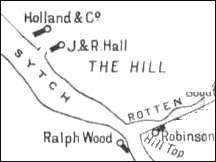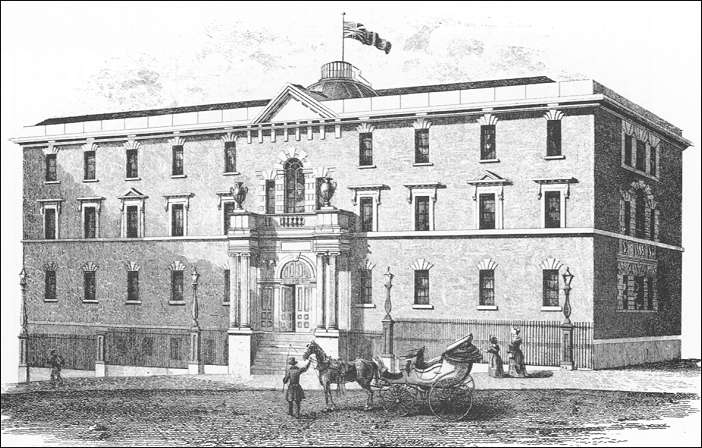![]()
Hill Pottery, Burslem
Old Hill Pottery, The Hill Top Pottery or Hill
Pottery
| These works, formerly belonging to Ralph Wood, were for many years - from about 1828 to 1859 - carried on by Samuel Alcock & Co., by whom they were rebuilt and enlarged in 1839, their rearranged manufactory comprising the works of J. & R. Riley (working period 1802-28), John Robinson & Sons, and William Taylor, which were all taken down for the purpose. |

from 1800 map
![]() The Hill Top Pottery was at the top of
a hill called "The
Sytch"
The Hill Top Pottery was at the top of
a hill called "The
Sytch"
which ran from Burslem at the top down to Brownhills at the bottom
| From | To | Occupier | Comments |
| Ralph Wood | |||
| 1802 | 1828 | J & R Riley | The works were used by J & R Riley (working period 1802-28), John Robinson & Sons and William Taylor. |
| 1828 | 1859 | Samuel Alcock & Co | Alcock rebuilt & enlarged the works in 1839 - The Hill Pottery of 1839 was designed by Thomas Stanley, a Shelton architect, who also designed St.John's Church and school in Goldenhill and St. Thomas's church in Mow Cop. |
| 1860 | 1863 | Sir James Duke & Nephews | In 1860, the works and general estate were purchased by Sir James Duke and Nephews and continued by them until 1863, when they sold it to Thomas
Ford. Sir James Duke & Nephews produced white & cream coloured earthenware services, china and Etruscan ware. |
| 1862 | 1870 | Morgan, Wood & Co | around 1862 - 1870 Morgan, Wood & Co, occupied part of the Hill Pottery |
| 1863 | Thomas Ford | ||
| 1864 | 1867 | Earthenware and Porcelain Company | the business was carried
on under the style of the Hill Pottery Company Ltd., late S. Alcock &
Co.
In 1867 the Hill Pottery Co was put into liquidation and the property once again came into the hands of Thomas Ford. |
| 1867 | Thomas Ford | In 1867 the works were divided into china and earthenware. | |
| 1867 | Alcock & Diggory | Alcock & Diggory took the china department (see the table below) | |
| 1867 | 1888 | Burgess & Leigh | In 1867 Burgess and Leigh took the earthenware department and then in 1888 the moved to a newly built factory at Middleport - The Middleport Pottery. |
| 1887 | 1916 | Samuel Johnson | Samuel Johnson may have shared part of the works with Burgess and Leigh, or they may have been at other works untill 1900 and then moved to the Hill Works. In 1916 they moved to the Britannia Pottery. |
The Hill Pottery China Works
|
Edwin James Drew Bodley worked part of Samuel Alcock's Old Hill Pottery at Burslem which had been divided into a china and a separate earthenware factory in 1867. The china works (now called Crown Works in 1882) were taken first by Bodley & Diggory and then by Bodley & Son until Edwin J.D. Bodley began to trade under his own name from June 25, 1875. |
| From | To | Occupier | Comments |
| 1867 | 1870 | Alcock, Diggory & Co | On the division of the Hill Pottery Company manufactory in 1867, part was carried on by Alcock, Diggory & Co. |
| 1870 | 1871 | Bodley & Diggory | Details of Bodley of the Hill Pottery |
| 1871 | 1874 | Edward F Bodley | Mr Diggory having retired in 1871. |
| 1874 | 1875 | Bodley & Son | Edwin F Bodley served as Mayor of Hanley in 1872-3. He retired and his son Edwin James Drew Bodley carried on. |
| 1875 | 1892 | Edwin J D Bodley | From 1875 to
October 31, 1888, he had William Telford as a partner, but this is not
reflected in the trade style E.J.D. Bodley. |
| 1895 | 1897 | Messrs. A Heath & Co. |

The Hill
Pottery
- click picture for more details -
Rebuilt for Samuel Alcock in 1839
and described at the
time as 'the most striking and ornamental object of its kind
within the precincts of the borough'
(from Ward 1843)
| "The Hill Top Pottery or Hill Pottery
These works, formerly belonging to Ralph Wood, were for many years - from about 1828 to 1859 - carried on by Samuel Alcock & Co., by whom they were rebuilt and enlarged in 1839, their rearranged manufactory comprising the works of J. & R. Riley (working period 1802-28), John Robinson & Sons, and William Taylor, which were all taken down for the purpose.
The fine early porcelain is unmarked and is often mistaken for Rockingham. Many finely modelled Parian jugs, etc., were made by Alcock's. Alcock ware is now little known, but it is of fine quality.....
The productions of Sir James Duke and Nephews were earthenware services, both white and cream-coloured, and china and Etruscan ware... The operations of the Hill Pottery Company were of short duration, for in 1867 it was put into liquidation and sold up, when the property again came into the hands of Thomas Ford. In the same year, the works were divided - the china department being taken by Alcock & Diggory and the earthenware part by Burgess & Leigh (late S. Alcock & Co.), who manufactured the ordinary as well as the higher and more artistic classes of earthenware goods, both for the home and foreign markets. The firm produced all the usual services, and useful as well as many highly ornamental articles. The mark used by the firm was a beehive on a stand, with bees, a rose-bush on either side, and a ribbon bearing the name of the pattern ('Kensington', for instance) beneath, and under this the initials of the firm, B.L. & Co. Messrs. Burgess, Leigh & Co. worked the Hill Pottery to 1899 and then this firm continued at the Middleport Pottery, Burslem.
On the division of the Hill Pottery Company manufactory in 1867, part was carried on by Alcock, Diggory & Co. In 1870, the firm became Bodley & Diggory; but in the following year, Mr. Diggory having retired, the manufactory was continued by Edward F. Bodley.
E. J. D. Bodley continued to 1892. Messrs. A. Heath & Co. were at the Hill Pottery from 1895 to 1897." Jewitt's Ceramic Art of Great Britain 1800-1900 |
questions/comments/contributions? email: Steve Birks